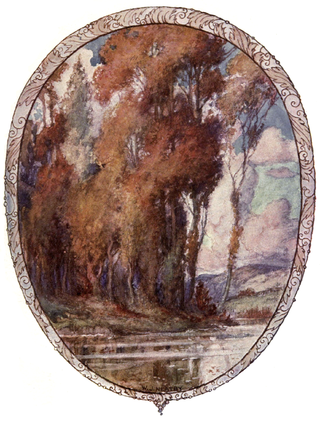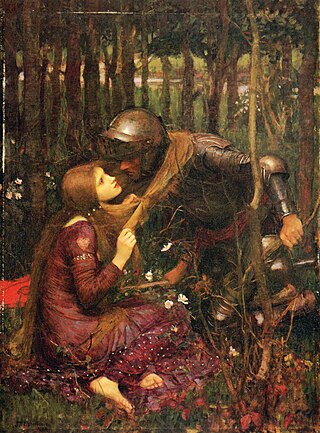
John Keats was an English poet of the second generation of Romantic poets, along with Lord Byron and Percy Bysshe Shelley. His poems had been in publication for less than four years when he died of tuberculosis at the age of 25. They were indifferently received in his lifetime, but his fame grew rapidly after his death. By the end of the century, he was placed in the canon of English literature, strongly influencing many writers of the Pre-Raphaelite Brotherhood; the Encyclopædia Britannica of 1888 called one ode "one of the final masterpieces". Jorge Luis Borges named his first time reading Keats an experience he felt all his life. Keats had a style "heavily loaded with sensualities", notably in the series of odes. Typically of the Romantics, he accentuated extreme emotion through natural imagery. Today his poems and letters remain among the most popular and analysed in English literature – in particular "Ode to a Nightingale", "Ode on a Grecian Urn", "Sleep and Poetry" and the sonnet "On First Looking into Chapman's Homer".

Agnes of Rome is a virgin martyr, venerated as a saint in the Catholic Church, Oriental Orthodox Church and the Eastern Orthodox Church, as well as the Anglican Communion and Lutheran Churches. She is one of several virgin martyrs commemorated by name in the Canon of the Mass.
Hyperion, a Fragment is an abandoned epic poem by 19th-century English Romantic poet John Keats. It was published in Lamia, Isabella, The Eve of St. Agnes, and Other Poems (1820). It is based on the Titanomachia, and tells of the despair of the Titans after their fall to the Olympians. Keats wrote the poem from late 1818 until the spring of 1819, when he gave it up as having "too many Miltonic inversions". He was also nursing his younger brother Tom, who died on 1 December 1818 of tuberculosis.

The calendar of saints is the traditional Christian method of organizing a liturgical year by associating each day with one or more saints and referring to the day as the feast day or feast of said saint. The word "feast" in this context does not mean "a large meal, typically a celebratory one", but instead "an annual religious celebration, a day dedicated to a particular saint".

"To Autumn" is a poem by English Romantic poet John Keats. The work was composed on 19 September 1819 and published in 1820 in a volume of Keats's poetry that included Lamia and The Eve of St. Agnes. "To Autumn" is the final work in a group of poems known as Keats's "1819 odes". Although personal problems left him little time to devote to poetry in 1819, he composed "To Autumn" after a walk near Winchester one autumnal evening. The work marks the end of his poetic career, as he needed to earn money and could no longer devote himself to the lifestyle of a poet. A little over a year after the publication of "To Autumn", Keats died in Rome.

"Ode to a Nightingale" is a poem by John Keats written either in the garden of the Spaniards Inn, Hampstead, London or, according to Keats' friend Charles Armitage Brown, under a plum tree in the garden of Keats' house at Wentworth Place, also in Hampstead. According to Brown, a nightingale had built its nest near the house that he shared with Keats in the spring of 1819. Inspired by the bird's song, Keats composed the poem in one day. It soon became one of his 1819 odes and was first published in Annals of the Fine Arts the following July. The poem is one of the most frequently anthologized in the English language.

"La Belle Dame sans Merci" is a ballad produced by the English poet John Keats in 1819. The title was derived from the title of a 15th-century poem by Alain Chartier called La Belle Dame sans Mercy.

"Ode on a Grecian Urn" is a poem written by the English Romantic poet John Keats in May 1819, first published anonymously in Annals of the Fine Arts for 1819.

Saint John's Eve, starting at sunset on 23 June, is the eve of the feast day of Saint John the Baptist. This is one of the very few feast days marking a saint's birth, rather than their death. The Gospel of Luke states that John was born six months before Jesus; therefore, the feast of John the Baptist was fixed on 24 June, six months before Christmas. In the Roman calendar, 24 June was the date of the summer solstice, and Saint John's Eve is closely associated with Midsummer festivities in Europe. Traditions are similar to those of May Day and include bonfires, feasting, processions, church services, and gathering wild plants.

The "Ode on Indolence" is one of five odes composed by English poet John Keats in the spring of 1819. The others were "Ode on a Grecian Urn", "Ode on Melancholy", "Ode to a Nightingale" and "Ode to Psyche". The poem describes the state of indolence, a word which is synonymous with "avoidance" or "laziness". The work was written during a time when Keats was presumably more than usually occupied with his material prospects. After finishing the spring poems, Keats wrote in June 1819 that its composition brought him more pleasure than anything else he had written that year. Unlike the other odes he wrote that year, "Ode on Indolence" was not published until 1848, 27 years after his death.
"Lamia" is a narrative poem written by the English poet John Keats, which first appeared in the volume Lamia, Isabella, the Eve of St Agnes and Other Poems, published in July 1820. The poem was written in 1819, during the famously productive period that produced his 1819 odes. It was composed soon after his "La Belle Dame sans Merci" and his odes on Melancholy, on Indolence, on a Grecian Urn and to a Nightingale and just before "To Autumn".

The Eve of St. Agnes is a Romantic narrative poem of 42 Spenserian stanzas set in the Middle Ages. It was written by John Keats in 1819 and published in 1820. The poem was considered by many of Keats's contemporaries and the succeeding Victorians to be one of his finest and was influential in 19th-century literature.
St. Mark's Eve is the day before the feast day of St. Mark the Evangelist. In liturgical Christian churches, this feast of St. Mark is observed on 25 April of each year; thus St. Mark's Eve is 24 April.

"Ode to Psyche" is a poem by John Keats written in spring 1819. The poem is the first of his 1819 odes, which include "Ode on a Grecian Urn" and "Ode to a Nightingale". "Ode to Psyche" is an experiment in the ode genre, and Keats's attempt at an expanded version of the sonnet format that describes a dramatic scene. The poem serves as an important departure from Keats's early poems, which frequently describe an escape into the pleasant realms of one's imagination. Keats uses the imagination to show the narrator's intent to resurrect Psyche and reincarnate himself into Eros (love). Keats attempts this by dedicating an "untrodden region" of his mind to the worship of the neglected goddess.
Saint Agnes of Rome (291–304) is a virgin martyr, a patron saint of chastity, feasted on 21 January.
Nationality words link to articles with information on the nation's poetry or literature.
Nationality words link to articles with information on the nation's poetry or literature.

In 1819, John Keats composed six odes, which are among his most famous and well-regarded poems. Keats wrote the first five poems, "Ode on a Grecian Urn", "Ode on Indolence", "Ode on Melancholy", "Ode to a Nightingale", and "Ode to Psyche" in quick succession during the spring, and he composed "To Autumn" in September. While the exact order in which Keats composed the poems is unknown, some critics contend that they form a thematic whole if arranged in sequence. As a whole, the odes represent Keats's attempt to create a new type of short lyrical poem, which influenced later generations.

The Eve of St Mark is a 1942 play by Maxwell Anderson set during World War II. It later became a 1944 film by 20th Century Fox that featured some of the same actors who repeated their roles in the film. The title is derived from the legend of St. Mark's Eve and the title of an uncompleted 1819 poem by John Keats.

"St. Agnes" is a poem by Alfred Tennyson, first published in 1837, revised in 1842, and retitled "St. Agnes' Eve" in 1857.













